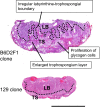In quest of genomic treasure
- PMID: 26400375
- PMCID: PMC4685213
- DOI: 10.1262/jrd.2015-098
In quest of genomic treasure
Abstract
It should be emphasized that "129" is not simply a number but is also the designation of a mouse strain that has made a great contribution to modern biological science and technology. Embryonic stem cells derived from 129 mice were essential components of gene-targeting strategies in early research. More recently, 129 mice have provided superior donor genomes for cloning by nuclear transfer. Some factor or factors conferring genomic plasticity must exist in the 129 genome, but these remain unidentified.
Figures



Similar articles
-
Production of cloned mice by somatic cell nuclear transfer.Nat Protoc. 2006;1(1):125-38. doi: 10.1038/nprot.2006.21. Nat Protoc. 2006. PMID: 17406224
-
Establishment of stem cell lines from nuclear transferred and parthenogenetically activated mouse oocytes for therapeutic cloning.Fertil Steril. 2008 May;89(5 Suppl):1314-23. doi: 10.1016/j.fertnstert.2006.11.203. Epub 2007 Nov 5. Fertil Steril. 2008. PMID: 17980868
-
[Parental genome imprinting].Ann Genet. 1993;36(1):63-9. Ann Genet. 1993. PMID: 8503652 Review. French.
-
Nuclear transfer-mediated rescue of the nuclear genome of nonviable mouse cells frozen without cryoprotectant.Biol Reprod. 2008 Oct;79(4):588-93. doi: 10.1095/biolreprod.108.069583. Epub 2008 May 28. Biol Reprod. 2008. PMID: 18509160
-
Cloning of embryos.J Reprod Fertil Suppl. 1990;40:227-34. J Reprod Fertil Suppl. 1990. PMID: 2192040 Review.
Cited by
-
Loss of H3K27me3 imprinting in the Sfmbt2 miRNA cluster causes enlargement of cloned mouse placentas.Nat Commun. 2020 May 1;11(1):2150. doi: 10.1038/s41467-020-16044-8. Nat Commun. 2020. PMID: 32358519 Free PMC article.
-
Aberrant imprinting in mouse trophoblast stem cells established from somatic cell nuclear transfer-derived embryos.Epigenetics. 2018;13(7):693-703. doi: 10.1080/15592294.2018.1507199. Epub 2018 Aug 23. Epigenetics. 2018. PMID: 30079806 Free PMC article.
-
Development of reproductive engineering techniques at the RIKEN BioResource Center.Exp Anim. 2017 Jan 27;66(1):1-16. doi: 10.1538/expanim.16-0074. Epub 2016 Oct 19. Exp Anim. 2017. PMID: 27760894 Free PMC article. Review.
References
-
- Wade CM, Kulbokas EJ, 3rd, Kirby AW, Zody MC, Mullikin JC, Lander ES, Lindblad-Toh K, Daly MJ. The mosaic structure of variation in the laboratory mouse genome. Nature 2002; 420: 574–578. - PubMed
-
- Abe K, Noguchi H, Tagawa K, Yuzuriha M, Toyoda A, Kojima T, Ezawa K, Saitou N, Hattori M, Sakaki Y, Moriwaki K, Shiroishi T. Contribution of Asian mouse subspecies Mus musculus molossinus to genomic constitution of strain C57BL/6J, as defined by BAC-end sequence-SNP analysis. Genome Res 2004; 14: 2439–2447. - PMC - PubMed
-
- Takada T, Ebata T, Noguchi H, Keane TM, Adams DJ, Narita T, Shin-I T, Fujisawa H, Toyoda A, Abe K, Obata Y, Sakaki Y, Moriwaki K, Fujiyama A, Kohara Y, Shiroishi T. The ancestor of extant Japanese fancy mice contributed to the mosaic genomes of classical inbred strains. Genome Res 2013; 23: 1329–1338. - PMC - PubMed
-
- Simpson EM, Linder CC, Sargent EE, Davisson MT, Mobraaten LE, Sharp JJ. Genetic variation among 129 substrains and its importance for targeted mutagenesis in mice. Nat Genet 1997; 16: 19–27. - PubMed
-
- Jiang LI, Nadeau JH. 129/Sv mice—a model system for studying germ cell biology and testicular cancer. Mamm Genome 2001; 12: 89–94. - PubMed
MeSH terms
LinkOut - more resources
Full Text Sources
Other Literature Sources
Research Materials

